Rare fish species are an important part of the world’s biodiversity, and their protection is critical to maintaining healthy ecosystems. For aquarium enthusiasts, keeping and raising rare and beautiful fish is a delightful hobby.
In this article, we will explore the top 11 types of rare fish, their intriguing facts, and what makes them unique. From the ornate sleeper ray to the Sakhalin sturgeon, we will take a closer look at these fascinating creatures and their habitats. While the identification of ocean species is ongoing, and biologists still have not named all the fish species, we will focus on the most well-known rare fish species.
You are reading: Top 11 Types Of Rare Fish
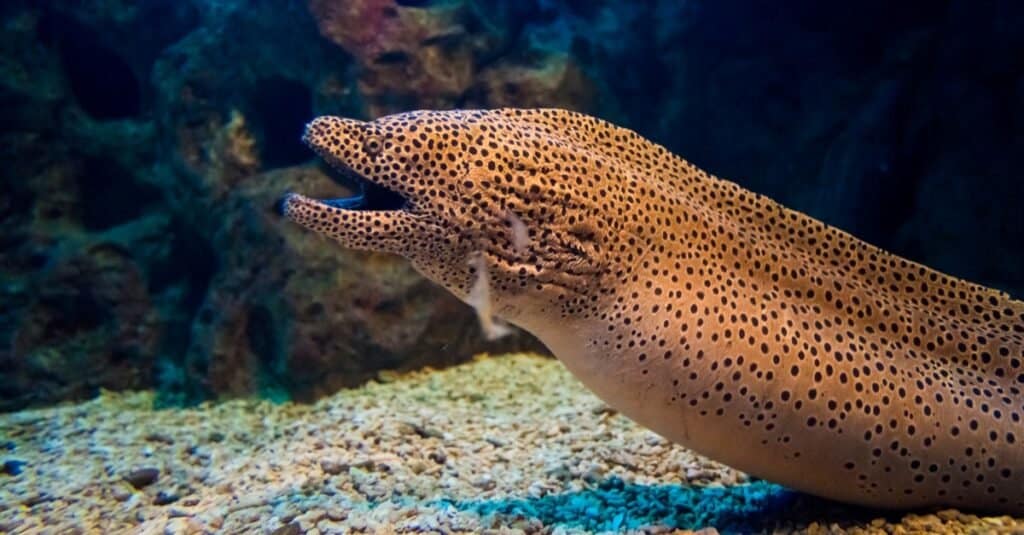
Top 11 Types Of Rare Fish
Ornate Sleeper Ray
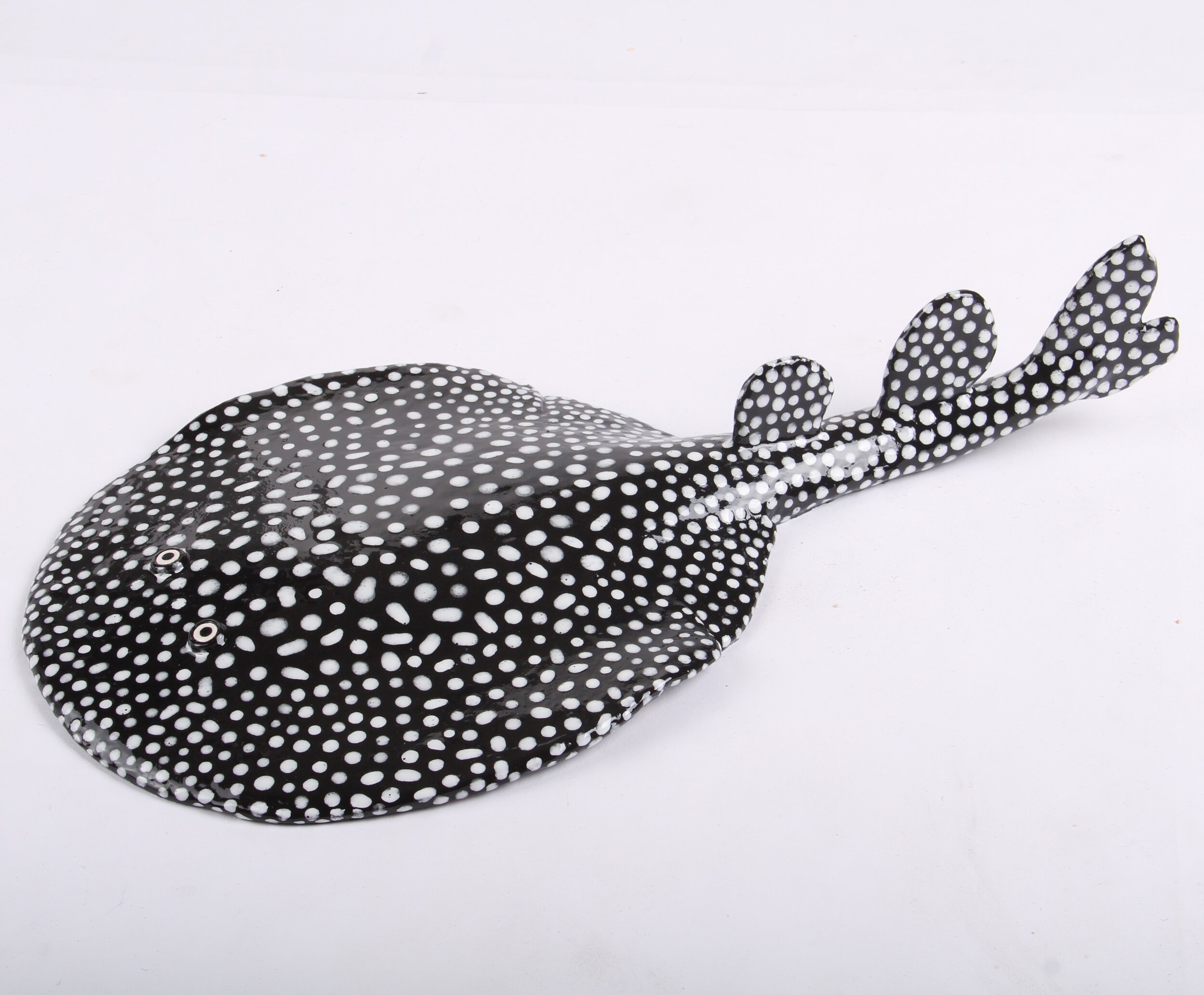
The ornate sleeper-ray, also known as Electrolux addisoni, is a species of electric ray in the family Narkidae, and the only member of the genus Electrolux. It is the largest known member of the sleeper ray family and is endemic to the coast of South Africa. The species was first recorded in 1984 but was not described until 2007.
The ornate sleeper-ray is a remarkable species with bold cream and brown markings, making it a popular choice for aquarium enthusiasts. It feeds on polychaete worms and small crustaceans and has only been seen by divers to feed during the daytime. The discovery of this species sheds light on the rich and diverse marine life in South Africa.
The ornate sleeper-ray was ranked as the number one newly described species of 2007 by the International Institute for Species Exploration. In an episode of Extinct or Alive, an ornate-sleeper ray is caught on footage feeding.
Devil’s Hole Pupfish

The Devils Hole pupfish (Cyprinodon diabolis) is a critically endangered species of the family Cyprinodontidae, found only in Devils Hole, a water-filled cavern in the US state of Nevada. It was first described as a species in 1930 and is most closely related to C. nevadensis and the Death Valley pupfish (C. salinus).
The Devils Hole pupfish is the smallest pupfish species in the genus Cyprinodon, with lengths up to 30 mm (1.2 in) and an average length of 23 mm (0.9 in) . Males and females differ in coloration, with males being overall dark brown with metallic blue on their sides, while females are silvery-blue.
The Devils Hole pupfish is limited to a deep limestone cave in Nevada, which provides its resident pupfish with conditions of constant temperature (92°F, 33°C) and salinity, unlike the fluctuating environments of many other pupfish.
The pupfish feeds and breeds on a shallow rock shelf near the surface, feeding on the algae and diatoms found there. The Devils Hole pupfish is considered an annual species, with the historic population fluctuating between 100 – 200 in winter and 300-500 in late summer. Starting in the mid-1990s, the Devils Hole pupfish population began what was to become a severe decline, and studies have been undertaken to better understand the reasons for the decline.
Eel
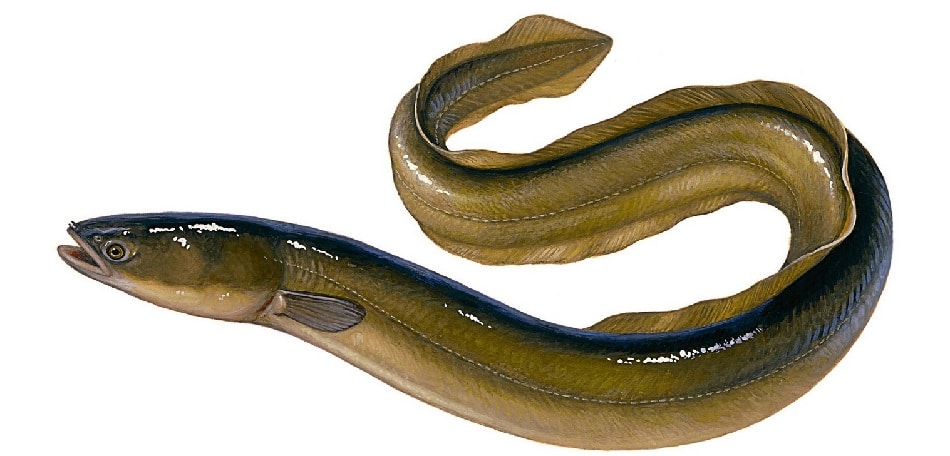
Eels are a diverse group of fish that belong to the order Anguilliformes, which consists of eight suborders, 19 families, 111 genera, and about 800 species. They are elongated fish that range in size from 5 cm (2 in) in the one-jawed eel (Monognathus ahlstromi) to 4 m (13 ft) in the slender giant moray.
Eels have worm-like bodies and no pelvic fins, and many species also lack pectoral fins. Their dorsal and anal fins are fused with the caudal fin, forming a single ribbon running along much of the length of the animal. Eels swim by generating waves that travel the length of their bodies, and to swim backward, they reverse the direction of the wave.
Eels are primarily predatory fish with carnivorous diets, and some species are cannibalistic. They feed on smaller fish, planktonic or benthic animals, and algae and diatoms.
Freshwater eels are fish belonging to the elopomorph superorder, a group of phylogenetically ancient teleosts, and are found in rivers and lakes around the world. The American eel (Anguilla rostrata) is a facultative catadromous fish found on the eastern coast of North America. Some freshwater eel species have become endangered due to human over-consumption.
American Paddlefish
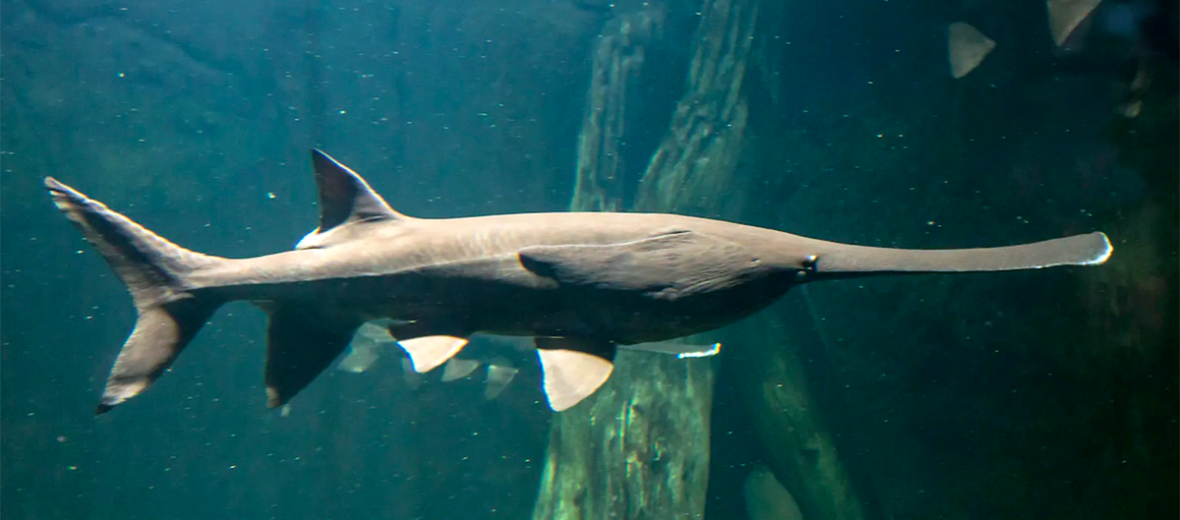
The American paddlefish (Polyodon spathula) is a species of ray-finned fish and the last living species of paddlefish. Here are some interesting facts about the American paddlefish:
Geographic Range
– The American paddlefish is native to the Mississippi River basin and once moved freely under the relatively unaltered conditions that existed prior to the early 1900s.
– It commonly inhabited large, free-flowing rivers, braided channels, backwaters, and oxbow lakes throughout the Mississippi River drainage basin, and adjacent Gulf Coast drainages.
– Its peripheral range extended into the Great Lakes, with occurrences in Lake Huron and Lake Helen in Canada until about 1917.
Physical Characteristics
– American paddlefish are among the largest and longest-lived freshwater fishes in North America.
– They have a shark-like body, average 1.5 m (4.9 ft) in length, weigh 27 kg (60 lb), and can live in excess of thirty years.
– For most populations, the median age is five to eight years, and the maximum age is fourteen to eighteen years.
– American paddlefish are smooth-skinned and almost entirely cartilaginous.
– Their eyes are small and directed laterally.
– They have a large, tapering operculum flap, a large mouth, and a paddle-like snout covered with electroreceptors to locate zooplankton and facilitate migratory behavior.
Habitat
– American paddlefish are mainly freshwater fish but can survive in brackish water.
– They generally reside in large rivers with deep water (greater than 6 meters) and slow-moving currents (less than 5 cm/s).
– Turbid (muddy) water is preferred by American paddlefish.
– During migratory breeding events, American paddlefish needs access to areas with sand or gravel bars.
Conservation Status
– The American paddlefish has been classified as a vulnerable species by the International Union for Conservation of Nature and Natural Resources (IUCN).
– The species has been overfished for its eggs, which are used to make caviar.
– The U.S. Fish and Wildlife Service has implemented conservation measures to protect the American paddlefish, including regulating commercial fishing and restocking programs.
Peppermint Angelfish
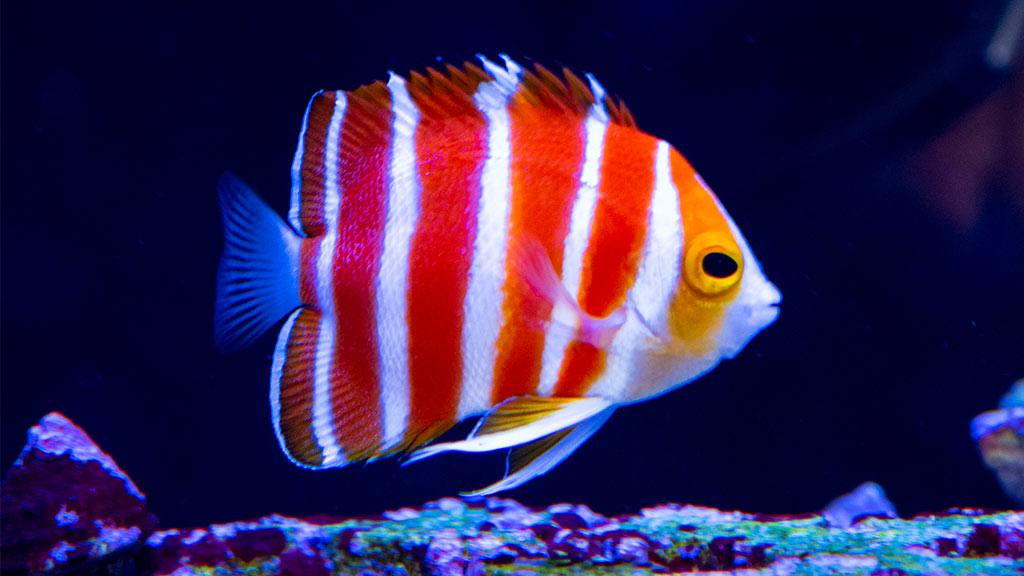
The peppermint angelfish (Centropyge boylei) is a small, colorful species of marine angelfish that belongs to the family Pomacanthidae. Here are some interesting facts about the peppermint angelfish:
Appearance
– The peppermint angelfish is a relatively small species, growing anywhere between 1 and 3 inches long.
– The front of the body is curved into a snout, whereas the back fins are square-shaped.
– The dorsal fin on the back has a spiny appearance.
– The most prominent characteristic of the peppermint angelfish is the five alternating vertical bright orange and white stripes along the entire body that resemble the peppermint candy for which they’re named.
– Their side fins and tail fin are completely translucent.
Habitat
– The peppermint angelfish is found in the central area of the South Pacific Ocean and is known to be native to the Cook Islands.
– It is primarily found in various locations throughout the Southern Pacific Ocean region, particularly around the Cook Islands.
– They prefer to hide in the rocky caves and coral reefs down to a depth of some 300 or 400 feet.
Diet
– The peppermint angelfish’s diet is thought to be made up of worms, crustaceans, sponges, tunicates, and detritus.
Conservation Status
Read more : Discover The 2 Types Of Rattlesnakes In Ohio
– The peppermint angelfish is occasionally exported as an aquarium specimen and can fetch high prices.
– Despite its popularity in the aquarium trade, the peppermint angelfish is not considered endangered and is listed as a species of least concern by the International Union for Conservation of Nature (IUCN) Red List.
Twaite Shad
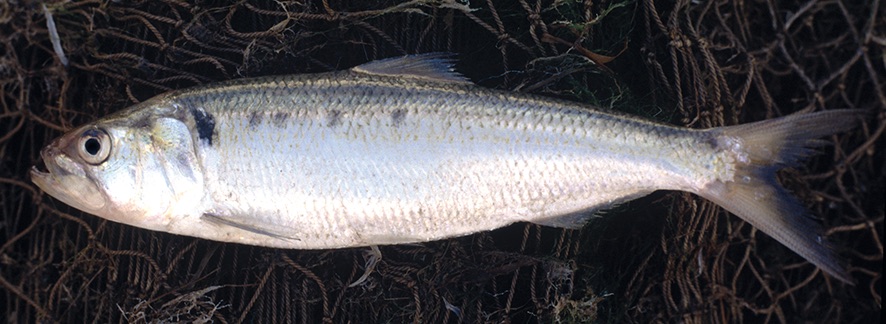
The twait shad (Alosa fallax) is a species of fish in the family Clupeidae. Here are some interesting facts about the twait shad:
Appearance
– The twait shad resembles an Atlantic herring but has a row of six to ten distinctive spots on its silvery flanks.
– It is deep-bodied and herring-like in appearance, with a sharp keel on its belly, radiating lines on the gill covers, and a distinct notch in the upper jaw.
Habitat
– The twait shad is an anadromous fish, which means it lives in the sea but migrates into freshwater to spawn.
– It is found in the eastern Atlantic Ocean and the Mediterranean Sea.
– As anadromous species, twait shad live in the sea as adults but migrate to freshwater to spawn.
– Twait shad are present in coastal environments across Europe, from southern Norway to the eastern Mediterranean.
Diet
– The twait shad is a planktivorous fish, feeding on small crustaceans and other zooplankton.
Conservation Status
– Populations of the twait shad have declined due to overfishing, pollution, and habitat destruction.
– The twait shad is considered a vulnerable species by the International Union for Conservation of Nature (IUCN) Red List.
– Conservation of this species is covered by Appendix III of the Bern Convention and Appendix II and V of the European Community Habitats Directive.
– Due to the rarity of this species, the twait shad has substantial legal protection.
Red Handfish
The red handfish (Thymichthys politus) is a species of handfish that is found in Frederick Henry Bay, Tasmania. Here are some interesting facts about the red handfish:
Appearance
– The red handfish is a small fish, measuring an average standard length of 61.4 mm (2.4 in) and an average total length of 80.1 mm (3.2 in).
– It is distinguished by its small, flattened wart-like protuberances that cover its body and red coloration.
– Two color morphs exist, a bright red morph with red color on both body and fins, with a black line separating the white fin edges and a mottled morph with a pink body covered in many red patches, with translucent pink fins expressing some bright red patches.
Habitat
– The red handfish is a benthic fish, preferring to hang around the sandy and rocky bottoms of the seafloor.
– It is currently known from only two small 50m long patches of reef in southeastern Tasmania, and is thought to have a total population of approximately 100 adults.
– The species is endemic to Tasmania’s eastern coast.
Diet
– Little is known about the red handfish’s diet, but it is thought to consist of animals that live in the benthos, such as small crustaceans and polychaete worms.
Conservation Status
– The red handfish is classed as Critically Endangered under the Australian Environment Protection and Biodiversity Conservation Act 1999.
– The species is arguably the most threatened marine fish in the world.
– Threats to the red handfish include small, very fragmented populations, local increases in density of native purple urchins, poaching for use as pets, and fragmentation of the populations, which is a challenge for reproductive success.
Neptune Grouper
The Neptune grouper (Cephalopholis igarashiensis) is a deepwater species of marine ray-finned fish, a grouper from the subfamily Epinephelinae which is in the family Serranidae. Here are some interesting facts about the Neptune grouper:
Appearance
– The Neptune grouper is a brilliantly-colored and modestly-sized deepwater serranid, with a maximum length of 30 cm (12 in).
– The species has a pink coloration with bright blue spots on the head and body, and a yellow tail.
Habitat
– The Neptune grouper is found on coral reefs at depths of 80 to 250 m (260 to 820 ft) in the Indo-Pacific.
– It is a demersal species, meaning it lives near or on the bottom of the ocean.
– The Neptune grouper has a depth range of 64-250m and does not migrate.
Diet
– Little is known about the Neptune grouper’s diet, but it is thought to feed on small fish and crustaceans.
Conservation Status
– The Neptune grouper is a rare and expensive species that is occasionally traded in the aquarium industry.
– The species is not considered endangered, but its population status is unknown.
– The Neptune grouper is also used as a food fish in some parts of the world, such as Japan.
– Due to its rarity and high demand, the Neptune grouper is difficult to catch, and it is considered a challenging fish to keep in captivity.
Tequila Splitfin
The Tequila Splitfin (Zoogoneticus tequila) is a species of freshwater fish from Mexico that belongs to the family Goodeidae. Here are some interesting facts about the Tequila Splitfin:
Appearance
– The Tequila Splitfin is a small fish, with males growing up to 5 cm (2 in) in length and females growing up to 7 cm (2.8 in) in length.
– The species is sexually dimorphic, with males having a golden halo around the caudal fin and a modified anal fin used for internal fertilization.
– The Tequila Splitfin is named after the Tequila Volcano, which looms near the type locality.
Habitat
– The Tequila Splitfin is endemic to the Mexican federal state of Jalisco and is found in rivers and small ponds.
– The species was historically only known from the type locality, the Río Teuchitlán.
– The Tequila Splitfin is now considered extinct in the wild, with only a few small populations remaining in captivity.
Diet
– Little is known about the Tequila Splitfin’s diet, but it is thought to feed on small invertebrates and algae.
Conservation Status
– The Tequila Splitfin is considered an endangered species by the International Union for Conservation of Nature (IUCN).
– After a few successful reintroductions of the Tequila Splitfin in the wild became established, the IUCN gave the species the status of endangered.
– The species is still considered by many to be extinct in the wild, and DNA analysis of natural populations of the Tequila Splitfin have shown that because the populations are extremely small, there is a large amount of inbreeding which could be contributing to the precipitous decline in populations in the wild.
Giant Freshwater Stingray
The giant freshwater stingray (Urogymnus polylepis or Himantura chaophraya) is a species of stingray in the family Dasyatidae. Here are some interesting facts about the giant freshwater stingray:
Appearance
– The giant freshwater stingray is the largest freshwater fish and the largest stingray in the world, growing up to 2.2 m (7.2 ft) across and weighing up to 300 kg (660 lb).
– The species has a flat, diamond-shaped body, a long tail with a venomous spine, and a dark brown or black coloration.
– The giant freshwater stingray has a unique dorsal fin that extends along the entire length of its back.
Habitat
– The giant freshwater stingray is found in large rivers and estuaries in Southeast Asia and Borneo, including the Mekong, Chao Phraya, Nan, Bang Kapong, and Mae Klong rivers.
– The species prefers deep, fast-moving water with sandy or muddy bottoms.
– The giant freshwater stingray is a solitary and nocturnal species, spending most of its time hiding in the riverbed.
Diet
– The giant freshwater stingray is a carnivorous species, feeding on fish, crustaceans, mollusks, and other aquatic invertebrates.
Conservation Status
– The giant freshwater stingray is considered a vulnerable species by the International Union for Conservation of Nature (IUCN).
– The species is threatened by habitat loss, overfishing, and dam construction.
– The giant freshwater stingray is also a popular target for sport fishing, and its meat and cartilage are highly valued in traditional medicine.
– Conservation efforts are underway to protect the giant freshwater stingray, including the establishment of protected areas and the promotion of sustainable fishing practices.
Sakhalin Sturgeon
The Sakhalin sturgeon (Acipenser mikadoi) is a species of fish in the family Acipenseridae. Here are some interesting facts about the Sakhalin sturgeon:
Appearance
– The Sakhalin sturgeon is a large fish, reaching a maximum recorded length of about 150 cm (59 in).
– The species has a long, pointed snout and a dark brown or gray coloration.
Habitat
– The Sakhalin sturgeon is found in the Tumnin River in Russia and the Sea of Japan.
– The species is anadromous, meaning it lives in the ocean but migrates upriver to spawn.
– The Sakhalin sturgeon is found in either a marine or freshwater environment within a demersal depth range and is native to a tropical climate.
Diet
– Little is known about the Sakhalin sturgeon’s diet, but it is thought to feed on small fish and invertebrates.
Conservation Status
– The Sakhalin sturgeon is listed as an endangered species by the International Union for Conservation of Nature (IUCN).
– The species is threatened by overfishing, habitat loss, and dam construction.
– Conservation efforts are underway to protect the Sakhalin sturgeon, including the establishment of protected areas and the promotion of sustainable fishing practices.
FAQS
-
What makes a fish species rare?
There are several factors that can contribute to a fish species being rare, including habitat loss, overfishing, pollution, and climate change. Some species are rare simply because they are difficult to find or have a very limited geographic range.
-
Why is it important to protect rare fish species?
Rare fish species are often endangered and play important roles in their ecosystems. Protecting these species helps to maintain healthy ecosystems and preserve biodiversity.
-
Can rare fish species be kept as pets?
Some rare fish species are kept as pets, but it is important to ensure that they are obtained from legal and sustainable sources. It is also important to provide appropriate care for the species and avoid contributing to the decline of wild populations.
-
Are all rare fish species endangered?
Not all rare fish species are endangered, but many are threatened by habitat loss, overfishing, and other factors. It is important to monitor and protect rare fish species to prevent them from becoming endangered.
-
How can I help protect rare fish species?
There are several ways to help protect rare fish species, including supporting conservation efforts, avoiding overfishing, reducing pollution, and reducing your carbon footprint. You can also learn more about rare fish species and share your knowledge with others.
Source: https://petstutorial.com
Category: Animals










